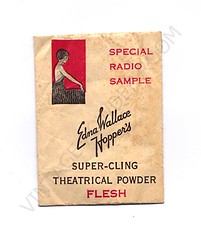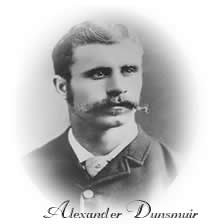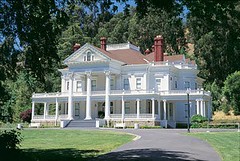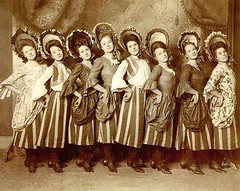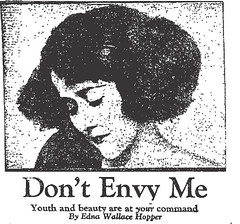Built in 1882, Mechanics’ Pavilion was a large barn-like structure that stood in Civic Center at Grove and Larkin. This building was the largest in San Francisco. The Pavilion was one square block (62,480 square feet of usable floor space) located where the current Bill Graham Civic Auditorium now stands. Annual events were very elaborate. They included parades, aerobatic feats, skate and bicycle races, and even floats. The first carnival was held in 1893 and attracted over 2,000 people.
With a seating capacity of nearly 11,000, the building was originally set up for concerts, political conventions, circuses, and religious assemblies, but within a few years, was best known for holding major prizefights. John L. Sullivan became the first of several world champions to appear there, staging a number of exhibition bouts in 1884, and returning in 1886 to knockout Paddy Ryan in three rounds.
Mechanics’ Pavilion’s most controversial fight took place on December 2, 1896, when Bob Fitzsimmons faced Tom Sharkey in a major heavyweight contest. Both competitors were dissatisfied with the list of possible referees, and the job ended up being handed to famed lawman Wyatt Earp.
Frontier lawman Wyatt Earp, legendary for his role in the archetypal Western gunfight, "Shoot-out at the O.K. Corral", is called upon this afternoon to officiate at a $10,000 heavyweight championship boxing match. As he strolls into San Francisco's Mechanics Pavilion to start work, police confiscate the ex-U.S. Marshall's six-shooter.
"Sailor" Tom Sharkey is the underdog against Australian heavyweight Bob Fitzsimmons, "the Freckled Wonder". Sure enough, Fitzsimmons knocks Sharkey cold in the eighth -- but referee Wyatt Earp calls a foul and awards the decision to Sharkey, lying unconscious on the canvas! Needless to say, outrage burns in the hearts of 15,000 men present (and the whole city) that the fight had been fixed!
The case went before a judge, and though Wyatt was -- if not specifically exonerated, at least not found guilty of fraud -- he was convicted in the court of public opinion.
But what on earth was Wyatt Earp doing in San Francisco standing in a boxing ring in the first place?
Well, it's all because of Josephine Marcus, a nice Jewish girl from San Francisco who'd run off with a traveling Gilbert & Sullivan theater troupe at the age of 18. Passing through Tombstone, Arizona, she'd met the tall, good-lookin' deputy U.S. Marshall there, and fell in love.
After the much-mythologized OK Corral gunfight (you remember, the Earps, Doc Holliday, the Clanton brothers) Wyatt Earp and Josie left Tombstone and wandered all around the West, settling down wherever a boomtown cropped up -- investing in mines, racing horses, running saloons and gambling parlors -- and south of the border, Wyatt had begun trading on his rough and ready lawman image by officiating at Mexican boxing matches. Sometime in the late 1890's, the Earps wound up living with Josie's parents back in San Francisco -- and there you have it.
We may never know exactly how Wyatt got mixed in the Sharkey-Fitzsimmons boxing boondoggle, or what his involvement truly was -- but in the aftermath of the scandal, the Earps left San Francisco, eventually settling down in Los Angeles. Wyatt wouldn't return to the Bay Area until his death in 1929, when his ashes were buried in Colma, in his wife Josie's family plot.
With a sellout crowd looking on, Fitzsimmons appeared the victor after sending Sharkey to the canvas in the eighth round, but was as surprised as anyone when Earp declared Sharkey the winner due to a foul. Whether Earp’s actions were sincere, or part of a betting coupe, has never been determined. But what on earth was Wyatt Earp doing in San Francisco standing in a boxing ring in the first place?
Well, it's all because of Josephine Marcus, a nice Jewish girl from San Francisco who'd run off with a traveling Gilbert & Sullivan theater troupe at the age of 18. Passing through Tombstone, Arizona, she'd met the tall, good-lookin' deputy U.S. Marshall there, and fell in love.
 |
| Josephine Marcus |
We may never know exactly how Wyatt got mixed in the Sharkey-Fitzsimmons boxing boondoggle, or what his involvement truly was -- but in the aftermath of the scandal, the Earps left San Francisco, eventually settling down in Los Angeles. Wyatt wouldn't return to the Bay Area until his death in 1929, when his ashes were buried in Colma, in his wife Josie's family plot.
In 1901, the State of New York temporarily banned professional prizefights, making San Francisco the epicenter of boxing for the next several years. James Jeffries, the heavyweight champion of that time, defended his title four times in the San Francisco, three of those bouts taking place at Mechanics’ Pavilion.
The only known film footage of a Mechanics' Pavilion fight is the November 15, 1901 heavyweight title fight between champion James Jeffries and Gus Ruhlin, Jeffries winning in five rounds...only a few minutes of film has survived.
Jeffries’ match with Jim Corbett, on August 14, 1903, became the most financially successful fight in San Francisco history up to that time, as 10,600 patrons paid over $60,000 to watch Jeffries defeat “Gentleman Jim” in ten rounds.
Jack Johnson fought at the pavilion in 1904, knocking out Sam McVey in 20 rounds!
Mechanics’ Pavilion was San Francisco’s first major indoor arena. Once considered the “Madison Square Garden of the West,” the pavilion became one of many casualties of the great earthquake, but not before having one last fling with notoriety.
It was 5:12 am on April 18, 1906 when San Francisco was hit with a 7.9 magnitude earthquake. Although Mechanics’ Pavilion survived the impact, nearby Central Emergency Hospital was not as lucky, much of it turning to instant rubble. By 5:30 am, patients from the hospital, along with people injured in the quake were brought into the arena, whose doors had been forced open. By mid-morning, Mechanics’ Pavilion had become both hospital and morgue, as beds from neighboring hotels were being brought in by the hour.
Unfortunately, by 1 pm, flames from the Hayes Valley fire reached the roof of Mechanics’ Pavilion, and chief surgeon Dr Charles Miller ordered the building evacuated. Within hours, Mechanics’ Pavilion was gone. (Brian Daley,sfcabletvexaminer2010-04-20)
Here's some info from a 1906 account from the The Call Chronicle Examiner, beginning after Dr. Millar ordered all patients removed.
"Every sort of vehicle was pressed into service and the dead and injured removed. The wounded were taken to Golden Gate Park, for there was no other haven of refuge not in the danger zone, and laid upon the grass. Many were taken into nearby houses by kind-hearted people and cared for. At the Harbor Hospital fully 100 injured persons had been treated up to 10 o'clock in the morning. Upon receipt of the news of the disaster torpedo boats and tugs loaded with navy and army doctors, nurses and sailors, were dispatched from the Mare Island Navy Yard and Goat Island and rendered great aid..."
Today's Civic Auditorium was built on the same site in 1915 in a majestic Beaux Arts style, and hosted the 1920 Democratic National Convention.
 |
| 1915 New City Hall and Civic Center |
 |
| S.F. Symphony Orchestra, Civic Auditorium, San Francisco, CA |
Franklin D. Roosevelt, the Republican nominee, gave a speech at the Civic Auditorium on September 24, 1932.(2)
On October 19, 1957, Chuck Berry, Laverne Baker, Frankie Lyman and the Teenagers, and Paul Anka appeared on the same bill.
It was the former home of the Golden State Warriors, of the NBA, from 1964-1966.
The Bammies were held here for several years in the 90's.
 |
| November 22, 1997, a room with day-glo sculptures and fluorescent lights where Ken Kesey and his buds did odd word games and made "music" on a wide variety of instruments. |
One end was the Ken Kesey room, which was completely decked out in complete psychadelia, from slide shows, light shows, paintings, etc. covering all the walls. It was so cool. A very small floor stage was set up in the middle of the room, where Ken Kesey and his Merry Pranksters were just hanging out and talking about a bunch of weird stuff. It was very cool in there, everybody was smoking tons of weed, and I saw a lot of great pipes and bongs. The security didn't give a shit, and I think it was the closest I'll ever get to the 60's/ Woodstock. Ken Kesey was trying to answer some questions, but it was fucked up so he didn't get to answer very many. He said the best thing he's ever done is made his "Further" school bus, which was parked outside. It is the raddest thing, for those who've never seen it. There were a few old-school hippies, deadheads, etc. This one deadhead in his 40's was totally on acid, and he had one of those 39 cent plastic microphones with springs in it where you talk and it echoes back to you. Anyways, this guy was trippin so hard he thought everyone could hear him, and he wouldn't leave the stage and let Ken tell his story, so Ken just left and went back stage and said he would come out later. It was a very intimate environment, with about a foot-tall stage unseparated from the audience.
 |
| Midnight: Same night, same place, November 22, 1997, Jane's took the stage after a trippy intro by the Merry Pranksters and a video of JFK's assasination. |
Now the site of the Bill Graham Civic Auditorium, the 62,000 square foot block has continued its role as a San Francisco major entertainment spot, now totaling almost 130 years.
Jerry performed here on
12/12/66 Grateful Dead
Promoter Bill Graham Presents.
This show was canceled.
6/15/75 Merl Saunders
Benefit for the Community Affairs Broadcast Foundation
Benefit for Friends of Inmates and Deputies[14]
The Energy Crisis with Jerry Garcia, Merl Saunders and Sweet Meat, Van Morrison, Dr. Hook and the Medicine Show, Larry Coryell, Chi Coltrane, Barefoot Jerry, Brother Mouse Band, Hoodoo Rhythm Devils, Soundhole, Brotherly Love, Pegasus, Caesar's Band, Lyons & Clark also performed.[3]
3/2/83 Bob Weir
Bammies Awards.
Jerry plays an acoustic guitar.
KFOG FM broadcast.
12/27/83 Grateful Dead
I:Cold Rain And Snow;C C Rider;They Love Each Other;Beat It On Down The Line; Althea;Cassidy;West L.A. Fadeaway;Hell In A Bucket>Might As Well
II:Scarlet Begonias>Fire On The Mountain;Samson And Delilah;He'sGone>Drums>Space>Throwing Stones>Black Peter>Sugar Magnolia
Encore:U.S. Blues
Promoter Bill Graham Presents.
Jerry plays the guitar Tiger.[19]
"These were the days. Jerry high as a kite, shirt and beard black with soot from smoking Persian out of tin foil. Same t-shirt and corduroys all tour, stinking to high hell. Bobby in a pink Lacoste shirt. Phil drunk off Heinekins. Fuck yeah."[7]
12/28/83 Grateful Dead
I:Feel Like A Stranger;Dire Wolf;Mama Tried>Mexicali Blues ;Loser;New Minglewood Blues;Bird Song
II:China Cat Sunflower>I Know You Rider;Playing In The Band>Drums>Space>The Wheel>The Other One>Stella Blue>Around And Around;Johnny B. Goode
Encore:It's All Over Now, Baby Blue
Promoter Bill Graham Presents.
Jerry plays the guitar Tiger.[20]
12/30/83 Grateful Dead
I:Bertha>Greatest Story Ever Told;Friend Of The Devil;Me And My Uncle>Big River; Ramble On Rose;Little Red Rooster;Brown Eyed Women;Looks Like Rain>Deal
II:Shakedown Street;Man Smart (Woman Smarter);Lady With A Fan>Space >Drums>Space>Truckin'>Wharf Rat>Good Lovin'
Encore:Keep Your Day Job
12/31/83 Grateful Dead
I:Jack Straw;Peggy-O;New Minglewood Blues;Candyman;My Brother Esau;Tennessee Jed;Hell In A Bucket>Don't Ease Me In
II:Sugar Magnolia>Touch Of Grey;Estimated Prophet>Eyes Of The World>Drums>Space>Throwing Stones>Not Fade Away;Brokedown Palace
III:Big Boss Man>Iko Iko;In The Midnight Hour;Goodnight Irene
The Band with Maria Muldaur, Mike Henderson opened.
Promoter Bill Graham Presents.
Rick Danko and Maria Muldaur sit in for the encores.[16]
Jerry plays the guitar Tiger.[22]
KFOG FM broadcast. and nationally broadcasted.
Maria Muldaur, Rick Danko and John Cippolina sit in for the third set.
"The Band was playing a set before the Dead came on and during the last song or two, Jerry was off stage right boogying like crazy. I'd never seen him dance before - obviously he was very much into The Band."[4]
This was the night Steve Parish family was killed just before the show.
During Iko, Mickey is standing and letting someone else sit and play at his set.
"Bill Graham pops out of this globe (huge mirrored ball) with a diaper on!"[5]
"I was there too, headed out a couple days later to Heavenly Valley for some skiing. The lift attendant, seeing the SYF sticker we placed on the rental car, said that Jerry was there on January 1, headed right up the lift."(6)
""I was there, saw a friend get kicked out for smoke bombs. He is an attorney now. He snuck right back in. On the way out they gave sack breakfasts. Oranges, juice, and I forgot what else."[8]
"Bill Graham’s annual New Years entrance was suitable theatrical (Father Time atop a spinning world globe, casting handfuls of roses to the huddled masses below), and was preceded by cryptic Orwellian thoughts and New Years greetings from band members and production staff via the huge video screens which the band Journey provided the Dead. Hundreds of balloons dropped and fireworks erupted as the Dead swung into their customary Sugar Magnolia.[13]
12/28/84 Grateful Dead
I:Touch Of Grey;Greatest Story Ever Told;Dire Wolf;Tons Of Steel;Down In The Bottom>I Ain't Superstitious;Dupree's Diamond Blues;Me And My Uncle>Mexicali Blues;West L.A. Fadeaway>Might As Well
II:China Cat Sunflower>I Know You Rider;Looks Like Rain;He's Gone>Spoonful>Space>Drums> Space>The Other One>Wharf Rat>Sugar Magnolia
Encore:Day Tripper
Promoter Bill Graham Presents.
Jerry plays the guitar Tiger.[21]
Steve Parish's wife, unborn child and daughter were killed in a car crash the night before this performance.
"Late that morning I drove into town to start setting up for the show. We’d been to a holiday party at a friend’s house in Woodacre the previous evening, and Lorraine had mistakenly left her purse behind. She said she was going to drive there to retrieve the purse in the afternoon, and then call me to discuss the possibility of joining me at the show.
I checked in a few hours later, just as Lorriane was getting ready to leave. She was running late and hadn’t yet picked up her purse. I told her I’d see her when I got home. I told her to drive carefully.
When I walked through the front door shortly after midnight, I was immediately struck by the stillness of our house. It was never that quiet, not even when Lorraine and Jennifer were sleeping. I checked the bedrooms. Both empty. I paced the floor a few minutes, wonder where they might be. I tried not to jump to conclusions, tried not to panic. Then I sat down in a chair and waited. This will probably sound strange, but I didn’t call the police, or anyone else for that matter. Something did not feel right. I thought about the dream, and about Lorraine and Jennifer out there on the road somewhere. It didn’t make sense that she would just disappear like this, that she wouldn’t call.
I didn’t sleep at all, just sat there in the living room, staring out the window, waiting for them to come home. Finally, around eight o’ clock, there was a knock at the door, and I opened it to find a dour looking gentleman with hat in hand standing on my front steps.
“Mr. Parish?”
“Yes.”
“I’m very sorry.” he said. “I have some bad news.”
My knees buckled. I had trouble breathing.. “They’re dead, aren’t they?”
He lowered his head. “Please…may I come in?”
“Not the baby, too God…not the baby.”
He held me up and walked me into the house. Then we sat down together in the living room as he delivered the kind of news that no one should have to deliver. He was the county coroner, so I’m sure he’d done this sort of thing before, but that made it no less painful. He told me there had been a car accident the previous night, that Lorraine was apparently driving back home from Woodacre when she failed to negotiate a sharp turn and crashed into a tree. She had died at the scene, along with our unborn child. Jennifer had survived the initial crash but was critically injured. Paramedics had taken her to a nearby hospital and worked furiously to save her life, but it was too late. She died shortly after arriving.
The next thing I knew I was out in the street, crying, running. A neighbor came out and stopped me. She grabbed me by the arms and pulled me close. “I’m so sorry,” she said. “I thought you knew the police were here last night and I told hem you were working in the city. “Why didn’t they come and tell you?”
I had no answer. I had no answer for anything. All I knew was that my world had collapsed, that my entire family had been wiped off the planet with a single breath. Just like that. They were all gone.
I went back into the house and called Lorriane’s parents. We had met once before, when Lorraine and I took Jennifer back East for a visit, but I didn’t know them well. I’d spent most of my time on that trip working with the band, which was playing in New York. It was always work for me. Work, work, work. Work came first. Play came second. Family third. Always. I don’t really remember exactly what I told them. I remember kind of spitting out the grim facts and then handing the phone off to the coroner to let him finish the job as Lorrain’s mom and dad cried on the other end. Then I got a phone call from Peter Barsotti, one of Bill Graham’s lieutenants, who had a question about the show, and I told him what had happened. He made a few phone calls and quickly the word spread. People started coming over. By early afternoon my house was full. Everyone from crew had stopped by to offer their condolences, to do whatever they could, which of course, was nothing. Everyone from the band came, too - everyone except Jerry, who was too disturbed and shaken by the incident to come in person. He could be that way: socially awkward to the point of embarrassment.
I forget who made the suggestion, but it was quickly determined that the Grateful Dead should cancel its shows for the new few days. But I said, no, that would serve no purpose. Again, I know it sounds crazy, but I felt the only way I could survive that experience was to get back to work, to be with the band and the crew, making music, doing the things I loved. It was distraction therapy, I know, but I had no alternative. I’d lost two children and a wife. I wasn’t thinking clearly. I knew only that I couldn’t just sit there and cry. Nothing made sense. Nothing except the music.
So we did the show that night, and the night after that, and the night after that. And it was remarkable experience, the way the guys in the band and the guys in the crew all rallied around me and hugged me and propped me up and told me how much they loved me. I should also say that Billy Crowe, along with Mickey Hart, insisted on going to the corner’s office to identify the body so I wouldn’t have to do it. They didn’t think I could handle that sort of trauma, and maybe they were right. I don’t know. Several people from the band stayed with me, making sure I was all right. Phil Lesh and his wife, Jill, were immensely giving and thoughtful. They were just starting their lives together, and their love was so strong and pure and clear that it had a palpable effect on me. It made me smile, made me think of the possibilities that life can bring. Bobby Weir stayed with me for days on end, listening to music, talking, just hanging out, the way friends do.
And then there was Jerry…
The first night, when I got to the show, Jerry approached me backstage and gave me a hug. He seemed so sad, so moved by my loss. And then, in a twisted but genuinely loving gesture, he did something that astounded me.
“Hey, man,” he said, his eyes brimming with tears. “You want some heroin? It’ll kill the pain.”
I thanked him but declined the offer. “If I did anything right now - one snort, one drink - I’d never stop.”
He nodded and told me again how sorry he was. In that instant I felt more pity for Jerry than I did for myself, because he really was trying to help. He just didn’t know any other way."[24]
12/29/84 Grateful Dead
I:One More Saturday Night;Friend Of The Devil;My Brother Esau;Big Railroad Blues;Cassidy;Althea;Let It Grow
II:Samson And Delilah;Lady With A Fan;Playing In The Band>Drums>Space>Truckin'>Stella Blue;Not Fade Away
Encore:Not Fade Away>Brokedown Palace
Promoter Bill Graham Presents.
Jerry plays the guitar Tiger.[23]
"Not Fade Away is real strong and there is never a time when the audience is alone! It just melds into Brokedown Palace without a true break."[9]
12/31/84 Grateful Dead
I:Shakedown Street;New Minglewood Blues;Peggy-O;Jack Straw>Bird Song;Hell In A Bucket>Don't Ease Me In
II:Sugar Magnolia>Scarlet Begonias>Fire On The Mountain;Man Smart (Woman Smarter)>Drums>Space>The Wheel>Throwing Stones>Turn On Your Lovelight
III:Gimme Some Lovin'>Uncle John's Band;Around And Around >It's All Over Now, Baby Blue
Promoter Bill Graham Presents.
FM broadcast
"Bill Graham takes the stage aboard a lighting bolt. The usual three-set year ender goes out over a nationwide radio hookup. Supporting acts include the a cappella group The Bobs."[17]
"I too was at this show however i was one of the lucky ones who got in for free. I was told to be at certain door rite before midnight. We were there and the door opened just we were told. As far the show goes yes good show however a little short for new years. They played fast and mean and the night was over as fast it started."[10]
"I was at this show. After Parish's loss the show was played with a huge wreath by the stage. The 3rd set and particularly this version of Baby Blue are excellent.
Jerry's normally emotional voice took on added feeling in some of the lines from Baby Blue. I thought at the time he was singing it for Steve."[11]
"And you really hear Garcia's pain in the jam between Scarlet and Fire. The tone of the guitar is amazing going thru many different sounds from scary, angry, sad, happy, high and the emotion in Jer's vocals still give me chills."[12]
1/28/87 Grateful Dead
I:Shakedown Street;Get Back;Peggy-O;Walkin' Blues;It Must Have Been The Roses;It's All Over Now;Row Jimmy;My Brother Esau;Bird Song;Jack Straw
II:When Push Comes To Shove>Samson And Delilah;Black Muddy River;He's Gone>Spoonful>Drums>Space>Eyes Of The World>Black Peter>Around And Around>Sugar Magnolia
Encore:U.S. Blues
Promoter Bill Graham Presents.
The day Bob's dog, Otis, died.
Dan Healy sings The Beatles Get Back.
3/12/88 Bob Weir, John Fogerty, Huey Lewis, Johnny Colla, Brent Mydland, Merl Saunders
Good Morning Little Schoolgirl, Turn On Your Lovelight, Long Tall Sally
Bammies Awards
Bay Area Musician of the Year - Jerry accepts, "Don't ever do this to me again".
Bob Weir and John Cutler accept the award for In The Dark.[15]
Jerry plays the guitar Tiger.
"Upon receiving his Best Guitarist award, Jerry said, “I don’t think of music as being a competition. I didn’t enter a contest to win this. This is for Deadheads everywhere and my partners, The Grateful Dead.” Among the evening’s musical highlights was a rendition of “Touch of Grey” in an orchestral arrangement, performed by Dick Bright (musical director of the Fairmont Hotel) and his Sounds of Delight. They also played “Good Morning Little Schoolgirl,” and “Turn On Your Love Light” with Huey Lewis, then finished with “Long Tall Sally” with Huey Lewis and John Fogerty. The evening ended with the Dead, Huey Lewis and the News, Merl Saunders, John Fogerty, and others onstage for a jam which, in the words of Relix magazine, “will go down in history as one of the great ones."[18]
12/22/90 Jerry Garcia Band
Promoter Bill Graham Presents.
I: How Sweet It Is, Mission In The Rain, That's What Love Will Make You Do, You Never Can Tell, Señor, Throw Out The Lifeline, Let's Spend The Night Together
II: The Way You Do The Things You Do, Lay Down Sally, And It Stoned Me, Tore Up Over You, Waiting For A Miracle, Don't Let Go, Struggling Man, Tangled Up In Blue
San Francisco Civic Auditorium (Bill Graham Civic), San Francisco, CA
1.)^1932-09-24, Spokane Daily Chronicle, pg. 8.
2.)^Daley, Brian, S. F. Cable TV Examiner, 2010-04-20.
3.)^http://www.thejerrysite.com/shows/show/1175
4.)^Sylvers, comments, 2008-04-25, http://www.dead.net/show/december-31-1983
5.)^oldeadhead, comments, 2009-01-09, http://www.dead.net/show/december-31-1983
6.)^Mike, comments, http://www.setlists.net/?show_id=1510
7.)^Cavaretta, Nick, comments, 2013-12-3-29, https://www.youtube.com/watch?v=xeGwfwJtu6w
8.)^August West, comments, 2013-12-12, https://www.youtube.com/watch?v=qnMxvi9WYIU&list=RDr_eaITn7ijk
9.)^thelegroom, comments, 2008-10-08, https://archive.org/details/gd1984-12-29.senn421.mccue.ford.81758.sbeok.flac16
10.)^jjg4762, comments, 2006-04-16, https://archive.org/details/gd84-12-31.sbd.gorinsky.6395.sbeok.shnf
11.)^gonearethedays, comments, 2004-08-23, https://archive.org/details/gd84-12-31.sbd.gorinsky.6395.sbeok.shnf
12.)^80's head, comments, 2004-07-16, https://archive.org/details/gd84-12-31.sbd.gorinsky.6395.sbeok.shnf
13.)^Grushkin, Paul, Relix Magazine, pg. 24, Grateful Dead 1983-1984 New Years.
14.)^MS 332 Ser. 3, Box 1:2, GDR: Show Files: GD Concert Dates-Tour Schedule, Grateful Dead Archives, Special Collections, McHenry Library, UC Santa Cruz, CA.
15.)^http://www.dead.net/tags/awards
16.)^Arnold, Corry, The Golden Road, 1986-summer, pg. 32.
17.)^Jackson, Blair; McNally, Dennis; Peters, Stephen; Wills, Chuck, Grateful Dead - The Illustrated Trip, pg. 305.
18.)^Jackson, Blair; McNally, Dennis; Peters, Stephen; Wills, Chuck, Grateful Dead - The Illustrated Trip, pg. 352.
19.)^Music Vault, Grateful Dead - Scarlet Begonias / Fire On The Mountain - 12/27/83 (OFFICIAL), https://www.youtube.com/watch?v=40Et-xVuLgU
20.)^Music Vault, Grateful Dead - China Cat Sunflower / I Know You Rider - 12/28/83 - San Francisco, CA (OFFICIAL), https://www.youtube.com/watch?v=NgjtIHDke9w
21.)^Voodoonola, Grateful Dead 12-28-84 SF Civic Auditorium SF CA, https://www.youtube.com/watch?v=_0yB03dU1os
22.)^Music Vault, Grateful Dead - Full Concert - 12/31/83 - San Francisco Civic Auditorium (OFFICIAL), https://www.youtube.com/watch?v=kjuKZBU8s8M&list=UUCwXWdQplS9iGCr1ivXHcJg&index=31
23.)^Voodoonola2, Grateful Dead 12-29-84 Civic Center san Francisco CA, https://www.youtube.com/watch?v=30HKZAfG6tk&list=RD30HKZAfG6tk#t=3
24.)^Parish, Steve, Home Before Daylight, pg. 234.
25.)^The Stanford Daily, Volume 128, Issue 25, 1955-10-28, http://stanforddailyarchive.com/cgi-bin/stanford?a=d&d=stanford19551028-01.2.43&srpos=1&e=-------en-20--1--txt-txIN-standford+stadium-ILLUSTRATION-----#











